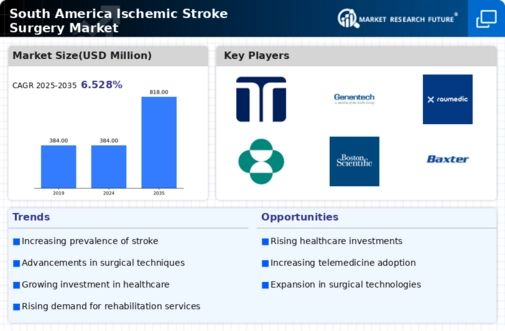Increased Healthcare Expenditure
The rise in healthcare expenditure across South America is a significant driver for the ischemic stroke-surgery market. Governments and private sectors are investing more in healthcare infrastructure, which includes the procurement of advanced surgical equipment and the establishment of specialized stroke units. For example, countries like Brazil and Argentina have reported increases in healthcare budgets by approximately 10-15% annually, aimed at improving stroke care. This financial commitment facilitates the adoption of innovative surgical practices and enhances the overall quality of care for stroke patients. As a result, the ischemic stroke-surgery market is poised for growth, supported by improved access to surgical interventions.
Advancements in Surgical Techniques
Innovations in surgical techniques and technologies are transforming the ischemic stroke-surgery market. Minimally invasive procedures, such as endovascular thrombectomy, have gained traction due to their effectiveness and reduced recovery times. These advancements not only improve patient outcomes but also lower the overall healthcare costs associated with stroke management. For instance, studies have shown that endovascular procedures can reduce hospital stays by up to 30%, which is a compelling factor for healthcare systems in South America. As hospitals adopt these cutting-edge techniques, the demand for specialized surgical instruments and training is likely to surge, further driving the growth of the ischemic stroke-surgery market.
Rising Incidence of Ischemic Stroke
The increasing prevalence of ischemic stroke in South America is a critical driver for the ischemic stroke-surgery market. Recent studies indicate that ischemic strokes account for approximately 87% of all strokes, with a notable rise in cases attributed to lifestyle factors such as hypertension, diabetes, and obesity. This trend necessitates advanced surgical interventions, thereby propelling market growth. The demand for effective surgical solutions is further amplified by the aging population, as older adults are at a higher risk for stroke. Consequently, healthcare providers are compelled to enhance their surgical capabilities to address this growing health crisis, which is expected to contribute significantly to the expansion of the ischemic stroke-surgery market in the region.
Growing Demand for Rehabilitation Services
The rising demand for comprehensive rehabilitation services post-stroke is influencing the ischemic stroke-surgery market. As awareness of the importance of rehabilitation in recovery increases, healthcare providers are expanding their services to include multidisciplinary approaches that integrate surgical care with rehabilitation. This trend is particularly evident in urban areas where access to rehabilitation facilities is improving. The integration of rehabilitation services not only enhances patient recovery but also encourages timely surgical interventions, thereby boosting the ischemic stroke-surgery market. Furthermore, the collaboration between surgeons and rehabilitation specialists is likely to foster innovative treatment pathways, further driving market growth.
Regulatory Support for Innovative Treatments
Regulatory bodies in South America are increasingly supporting the introduction of innovative treatments and technologies in the ischemic stroke-surgery market. Streamlined approval processes for new surgical devices and techniques are encouraging manufacturers to invest in research and development. For instance, recent initiatives have reduced the time for clinical trials and product approvals, facilitating quicker access to advanced surgical options for patients. This regulatory environment not only enhances competition among manufacturers but also ensures that patients benefit from the latest advancements in stroke care. As a result, the ischemic stroke-surgery market is likely to experience accelerated growth, driven by the influx of innovative surgical solutions.


















Leave a Comment